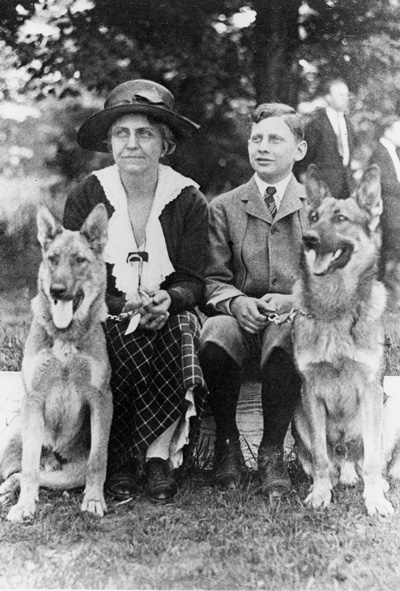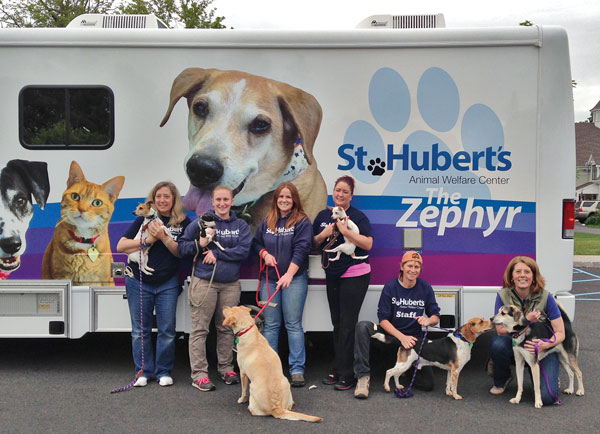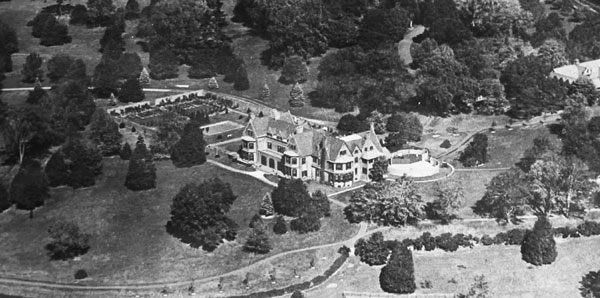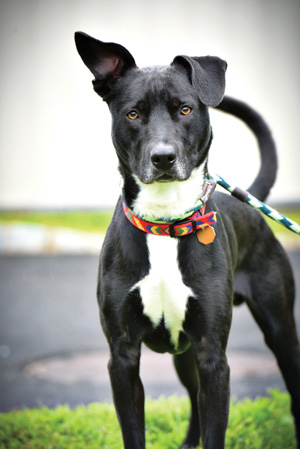Of all the things that Geraldine Rockefeller Dodge left behind—the thirty-five room mansion, hundreds of acres of prime real estate in one of the nation's wealthiest counties, a Fifth Avenue townhouse, enough sterling silver trophies and bronze sculptures to sink a small ship, museum quality paintings, and a forty-four carat sapphire, St. Hubert's Giralda may have been the one she valued most.

Toward the end, surrounded by all the trappings that nearly one hundred million dollars can buy, the niece of John D. Rockefeller, king of Standard Oil, had an epiphany. She shut down her annual purebred dog show—considered among most luxurious and successful in the world—to lavish her wealth and attention on strays.
“To this unhappy segment of dogdom,” the heiress wrote, in a formal letter announcing the decision, “I now give top priority of my time and strength.”
In the time she had left, she concentrated her resources on bolstering the animal rescue operation she'd founded in 1939: St. Hubert's Giralda. She'd named it for St. Hubert, an 8th century saint and her home: Giralda Farms, a vast Morris County estate. A patron saint of hunting, St. Hubert gained a reputation as a savior of canines when he brandished the cross as a treatment for rabies.
More than forty years after Mrs. Dodge's death, the vision and mission continue. Unhappy dogdom finds a steady stream of help at St. Hubert's, whose headquarters still stand on the southern sliver of Giralda Farms land where it began. (While Mrs. Dodge's will left St. Hubert's Giralda land as well as a modest endowment, Dodge money no longer funds St. Hubert's, which now depends on other sources of support. An earlier will had left St. Hubert's Giralda the bulk of her estate).
But this is a “new” St. Hubert's: St. Hubert's Animal Welfare Center. A $12 million capital campaign and building project that broke ground in 2009 produced major expansion of the facilities, officially opening this October. Adding substantially to the old estate barn that Mrs. Dodge converted to kennels and a shelter years ago, the Center houses and ministers to abandoned, abused and lost dogs and cats (as well as injured or orphaned birds, ferrets, wildlife, and other animals in need).
“Compassion,” notes President and CEO Heather J. Cammisa—and promoting a healthy bond between animals and humans—stands at the core of everything the organization undertakes.
St. Hubert's aims to reduce the number of animals needing its services by looking “upstream,” as Cammissa puts it, to the source of the problem. That means educating and enlightening people with pets. The Center develops programs and resources for caring people with pets who are facing tough human challenges, including poverty and domestic violence. The new St. Hubert's builds on the original Dodge vision, providing a pet food pantry, a call-in Pet Helpline, staffed by a Pet Retention Coordinator who can answer questions and offer advice. It tries to reduce the number of homeless cats and kittens through a low cost spay and neuter program for “community cats,” who have no home but are fed by people in their neighborhood. It advocates for improved living conditions for domestic as well as farm animals; registered vigorous opposition with the New Jersey legislature against allowing gestation crates for pigs; serves vegetarian-only meals at its events. It also owns and operates a shelter in North Branch, New Jersey. Both shelters are open seven days a week for adoptions. In 2014, more than six hundred animals arrived at St. Hubert's Giralda's doors, with more than 90% finding homes. Raising consciousness “upstream,” its humane education program connected with more than four thousand children. Children's birthday parties invite boys and girls and their guests to mingle with animals, and sponsoring housing for a needy dog or cat is part of the birthday “package.”
Addressing the worst cases—dogs so damaged by horrible living conditions that they could be unadoptable—St. Hubert's now houses an ASPA program for dogs rescued from animal hoarders, abusers and puppy mills. The ASPCA Behavioral Rehabilitation Center at St. Hubert's cares for them in a separate unit where they work with staff on gaining confidence and curbing behavior problems from aggressiveness to aversion to human beings, so they can be adopted into normal homes.

The Center tries to understand each dog and individualize its treatment, recording personalities and preferences on a master chart for staff reference. A Pitbull/Terrier mix, “‘Money Boo Boo'” the chart says, “likes snuggles and rope toys.” “‘Mocha,' a combination Lab/Chow Chow, wants any squeaky possible.”
Geraldine “Gerrie” Rockefeller grew up an animal lover on her family's estate, Rockwood Hall, near Sleepy Hollow, New York. When she married Marcellus “Marcy” Hartley Dodge, a Princeton graduate, in 1907 they were dubbed richest couple in America. She brought more money to the marriage than he did, though his resources were also vast; his family owned Remington Arms. At one point, he was the majority owner of the New York Times.
A year after the marriage, Gerrie's father, William Rockefeller, brother of John D., bought a huge gabled mansion tucked out of sight and surrounded by hundreds of acres of property stretching from Madison Avenue in Madison south to Chatham Township. He presented it to the newlyweds as a gift. For most of their marriage, though, the Dodges lived in separate homes; she favored Giralda Farms; he a more modest house at his family's Hartley Farms. A wide cleared path connected the two estates, and “Marcy” was said to greet Mrs. Dodge whenever she returned from her weekly shopping trips to New York, where she routinely stayed two nights in her townhouse on Fifth Avenue. Rumors stemming the unusual living arrangement were inevitable; still, the marriage lasted until Mr. Dodge's death on Christmas in 1963.
Mrs. Dodge adored the company of dogs. “As many as ten dogs slept in her bedroom at night, each in its own basket,” Newsweek reported after her death. She had a 1936 Cadillac outfitted as a canine transport vehicle, with multiple doors and space for a dozen dogs to ride inside. She fancied German Shepherds and English Cocker Spaniels, founded the venerated Morris & Essex Kennel Club dog show, was the first woman to act as the only judge of the Best in Show competition at the Westminster Kennel Club Dog Show and was a respected breeder (more than eighty breeds were raised at Giralda Farms Kennels, registered with the American Kennel Club in 1921). Hers was, according to some, the World According to Dogs: word had it that when a Dodge dog bit an employee, it was the employee who was let go.

The heiress' interest in rescuing dogs may have been spurred by a wayward member of her adored household pack, a wire haired terrier named Sam, who wandered off the estate a few days before Thanksgiving a hundred years ago this November. Distraught over Sam's disappearance, Mrs. Dodge posted a reward and enlisted the William J. Burns detective agency to find the dog. (A local carpenter from Hanover eventually returned him.)
For years, the mission of St. Hubert's Giralda, which she'd incorporated as a non-profit, was overshadowed by the demands of her annual Morris & Essex Dog Show. But in the late 1950s, writing on Morris & Essex Kennel Club letterhead, Mrs. Dodge announced she was closing the show, running since 1927, in favor of a new direction. “I am turning my attention,” she wrote “to another phase of the dog problem where assistance is sorely needed.”
She apologized for shuttering the dog show, held annually with great fanfare, flags flying with a catered lunch on the polo grounds at Hartley Farms, saying “I hope my friends will understand.” (Dog fanciers still revere Mrs. Dodge and have revived the Morris & Essex Kennel Club, which will host its dog and art show at Colonial Park in Somerset on October 1st.)

Long before animal rights and welfare were trending, St. Hubert's fledgling shelter staff took to the streets. The shelter hired radio dispatchers who handled thousands of calls annually reporting lost or abused animals. Off duty animal wardens slept in rooms upstairs. Three ambulances patrolled ninety square miles in search of strays and emergencies. The dogs they picked up arrived at Giralda Farms below Mrs. Dodge's mansion, on the Chatham Township side, where the kennel entrance was flanked by bronze statues of purebreds: one of a pointer, the other of a setter.
The kennels were just the beginning. Like St. Hubert's in 2015, the earlier organization aimed not only to house needy dogs, but to solve the problems that sent dogs St. Hubert's way. It set out to educate the public. Advisors fielded inquiries from pet owners and offered tips on taking taking care of dogs and “proper pet selection.” There were meeting rooms, lectures, rings for obedience training and Seeing Eye puppy training classes. St. Hubert's boiled its mission down to two “vital” messages, promoting “Fair Play to Animals” and “Civic Responsibility of People Who Own Pets.”
Mrs. Dodge long intended to move St. Hubert's Giralda shelter and operations to a 133-acre tract of land she owned in Parsippany, along Route 46 West, bordering an entrance to the town of Mountain Lakes. But the move never materialized, and in the 1960's, after her health deteriorated, that property was sold, and the shelter stayed on the grounds of her home.
For years, Mrs. Dodge, who lost her only child, Marcellus Hartley Dodge Jr. (“Hartley”), to a car accident in France in 1930, when he was just out of Princeton, filled her home not only with dogs but also with images of them. The mansion teemed with bronzes and paintings. To manage it all, she retained a curator. And to capture the likenesses of her favorite dogs and champions she hired famed English artist, R. Ward Binks.
After her death, artwork was auctioned, but many pieces landed at St. Hubert's. To accommodate them, the former barn/kennel sprouted a gallery (in a converted hayloft) as well as a library, which held volumes of books on canine and animal subjects. Ultimately, St. Hubert's sold much of its collection to support its mission. Some of the last items remaining were ultimately turned over for sale to William Secord, whose Manhattan gallery specializes in animal art, including the bronze pointer and setter that flanked the entrance. A bronze of St. Francis remains on the Shelter's grounds.
“It really would have been most appropriate in a house museum,” says Secord of Mrs. Dodge's collection, “but there really wasn't any house.” Indeed, when the Giralda Farms' land was sold for commercial development as a corporate park, the house was demolished. The Secord Gallery, open by appointment only, still has some sterling silver trophies, 19th century bronzes and a Rosa Bonheur painting from the Dodge collection for sale. Some art from her collection also resides nearby in the Dodge Room at the Morris Museum.
A remnant of Mrs. Dodge's estate, in private hands for well over a century, is now open to the public. The Chatham Township Open Space committee, in partnership with the Open Space Institute and Morris County Parks Commission preserved 136 acres of the property, adjacent to and within view of St. Hubert's Animal Welfare Center, naming it the “Giralda Farms Preserve.” The Geraldine Dodge Foundation, among others, helped fund the $14 million purchase, of which $10 million came from a Morris County Open Space Fund grant—its largest single grant ever.

“This is a place for all residents of the town and county to enjoy acres of beautiful, natural land for walks, biking, wildlife watching, and concerts” says Joe Basralian, chair of Chatham Township's Open Space Committee. The area, long the site of the annual Giralda Music and Arts Festival, connects with miles of Loantaka Brook Reservation trails across Woodland Avenue. Although the Preserve paths loop within sight and earshot of an entrance to the corporate park, an off hours visit gives a sense of the solitude and gentle grandeur of the landscape Mrs. Dodge and her dogs enjoyed. Some of the wide gravel paths are said to correspond to routes she took on her daily carriage rides, accompanied by her dogs, passing stately trees, herds of deer, meadows, fields and woodlands. The Preserve also supports a cause her husband spearheaded: it helps protect the watershed impacting the Great Swamp National Wildlife Refuge, which Marcellus Hartley Dodge and prominent allies saved from development as an airport site in the 1960s. It is also—fittingly—open not only to people, but to pet dogs (properly leashed).
St. Hubert's Animal Welfare Center is located at 575 Woodland Rd. in Madison. Click or call 973/377-2295.
The Jacobus Vanderveer house is the only surviving building associated with the Pluckemin encampment.
Dedicated to preserving the heritage and history of the railroads of New Jersey through the restoration, preservation, interpretation and operation of historic railroad equipment and artifacts, the museum is open Sundays, April thru October.
Even today, if you needed a natural hideout—a really good one—Jonathan’s Woods could work.
Paths of green, fields of gold!
The Millstone Scenic Byway includes eight historic districts along the D&R Canal, an oasis of preserved land, outdoor recreation areas in southern Somerset County